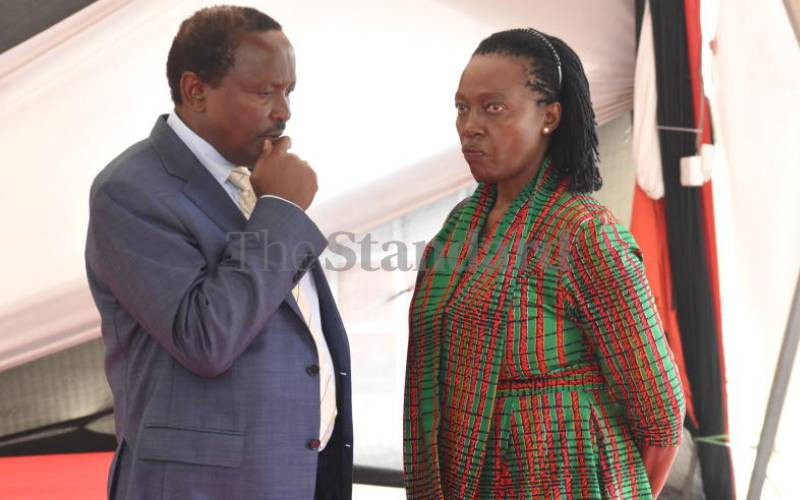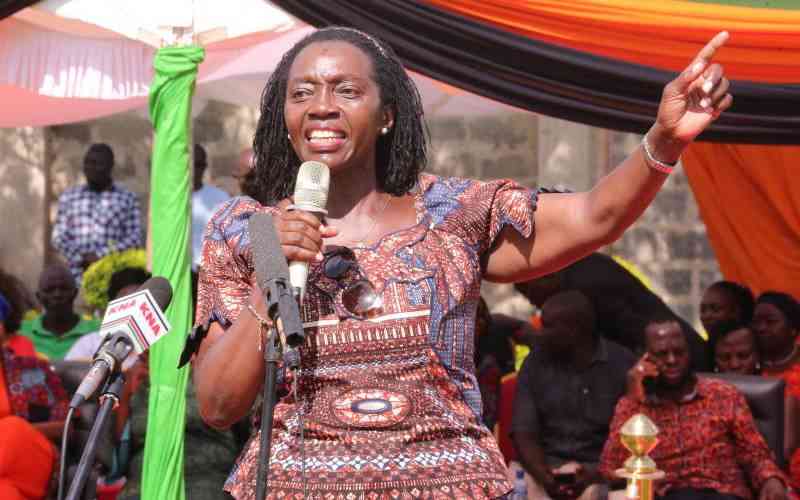 |
|
Mzee Nguri proudly displays his teeth that have remained intact for 9 years |
Times were when war against rats was a matter of survival for chiefs around the Mount Kenya region.
The chiefs were required to prove their seriousness by the number of the rodents’ tails they presented to the colonial authorities on a daily basis and they (the number of rats’ tails would mean promotions, demotions or even sacking.
What a revelation!
Mzee Jotham Guchu Nguri, 91, who witnessed it all in his childhood laughs off my surprise, displaying a white and unbreached set of teeth that only adds to my amazement. He says he has never lost a single tooth nor visited a traditional or conventional dentist in his life.
“My father died when he was over 70, with all his teeth intact. I think I inherited his strong teeth. My mother was not as lucky,” he says, flashing the teeth with an exaggerated grin.
I stare at him, agape, hanging on his every words as I mull over the rate at which young people are losing their teeth these days.
Back to rats, he says: “You may not know it, but rats and the plague they carried came with the white people and Indians,” he says. “These foreigners also brought with them jiggers that are a menace to this day.”
After a pause and a sip of his tea, made with soya milk, he says: “You see, rats were found to be the cause of Bubonic plague, a bacterial infection that sent legions to their graves in the mid 1930s.
Deposit tails of rats
“Fleas that lived off the rats transmitted the killer disease. Colonial authorities declared war on the rats and directed the chiefs who were immensely powerful at the time to mobilise their subjects to annihilate the rodents.
Chiefs would troop to Kerugoya every evening before sunset to deposit the tails at the local hospital that was the collection point.”
That story that left me in stitches and cleared my doubts over Mzee Nguri’s age.
The era when folks were forced to kill rats and chop of their tails must be a distant one.
He stands straight as a ramrod and walks unaided, with only a slight totter. He does not wear spectacles and his hearing is not impaired.
From Kutus where I met him tending to his businesses which include rental houses, to his home in Kiangwenyi village which hugs Mount Kenya Forest, he sat on the wheel of a pick-up truck he has driven for decades with startling ease. Only the white vegetation on his head reminded me that I was being driven by an old man.
Stay informed. Subscribe to our newsletter
Well-kept compound
“Few people of your age drive themselves,” I said as we alighted next to an impressive house at his well-kept compound which is surrounded by tea bushes. It is a five bedroomed edifice that cost him a whopping sh15,000 in 1960. Whopping because his monthly salary at the time was only sh55.
“I drive to Nairobi occasionally to attend to some of my businesses there, but I am accompanied by a driver these days to help me navigate through the crowded streets and the confusing Thika highway,” he says. “But I avoid driving by night.”
Nguri shows me around the compound where carpet like grass and beautiful flowers blend with exotic and indigenous trees, rendering the home exquisitely beautiful.
We sit on the veranda, chatting over a steaming cup of tea, ideal for the chilly weather.
Amid sips, Mzee Nguri walks me down his long life from birth in 1923, as the first child of Guchu Nguri and Juliana Mumbi.
“We were only two boys. My brother, James Thiaka who lives in the neighbourhood is 14 years my junior. He was born in 1937. Note that family planning was unknown those days.
“I went to Kahuhia Teacher Training College in 1941 and 1942 after completing Standard eight at Kagumo Government Primary School.
“I was employed as a teacher shortly afterwards and was posted to Ngariama Primary School as a headteacher from 1943 to 1945 after which I was transferred to Gatunguru Primary School where I remained until 1950.
“Among my students was Jackson Karua, the father of former Cabinet Minister Martha Wangari Karua. From 1951 to 1952, I was the headteacher of Kabare Primary School, now a national Girls’ Secondary School,” he says.
 The Standard Group Plc is a
multi-media organization with investments in media platforms spanning newspaper
print operations, television, radio broadcasting, digital and online services. The
Standard Group is recognized as a leading multi-media house in Kenya with a key
influence in matters of national and international interest.
The Standard Group Plc is a
multi-media organization with investments in media platforms spanning newspaper
print operations, television, radio broadcasting, digital and online services. The
Standard Group is recognized as a leading multi-media house in Kenya with a key
influence in matters of national and international interest.
 The Standard Group Plc is a
multi-media organization with investments in media platforms spanning newspaper
print operations, television, radio broadcasting, digital and online services. The
Standard Group is recognized as a leading multi-media house in Kenya with a key
influence in matters of national and international interest.
The Standard Group Plc is a
multi-media organization with investments in media platforms spanning newspaper
print operations, television, radio broadcasting, digital and online services. The
Standard Group is recognized as a leading multi-media house in Kenya with a key
influence in matters of national and international interest.









